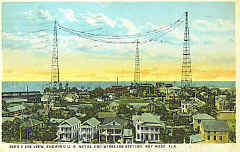Washington DC
Main Navy Building (1947) - note antennas - this was the receiver site
before Cheltenham was established
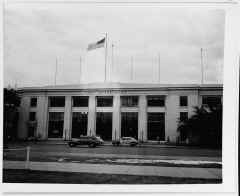
|
Navy Dept Communications Office 1919
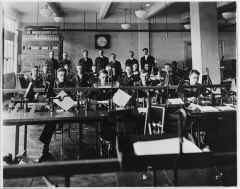
|
1944 Film -
including NSS operations
RE, RF, RG receivers at Washington Communications Station (1932)

|
1919 - Transatlantic Wireless Room - "Reading the radio tape
upon which messages are received in code by means of perforation."
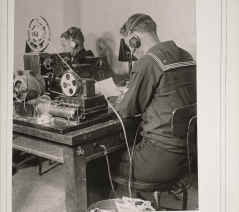
|
1944 Film
- including NSS operations
|
Radio Central 1923
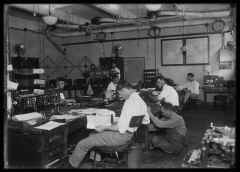
|
Transatlantic Radio 1923
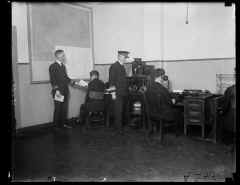
|
More Washington DC
photos
- thanks to Society of Wireless Pioners
|
NAA Arlington
|
NAA Spark Transmitter 1913
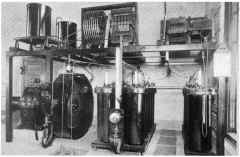
|
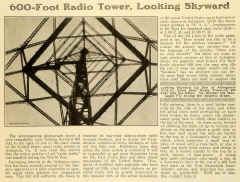
|
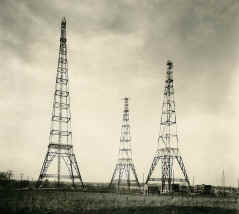
|
NSS Annapolis - Click Here for lots
more info and photos
|
|
|
NSS - US Navy Photo 3/35
- high-res (5Kx3K) version
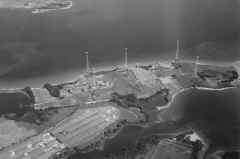
|
NSS - US Navy Photo 11/25/69
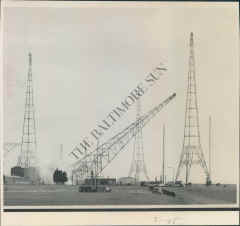
|
NSS Annapolis 800' antenna tower - 1954 - US Navy Photo
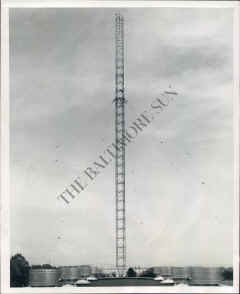
|
NPO Cavite, Philippines
|
NPO Cavite, Philippines 1927
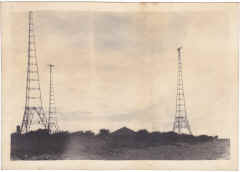
|
NPO Cavite, Philippines 1930 - Sangley Point antenna towers in
background
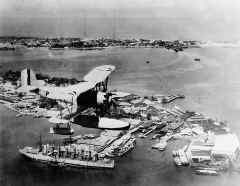
|
NPO Cavite, Philippines 1934 - Sangley Point antenna towers in
background

|
NPO Cavite, Philippines 1940
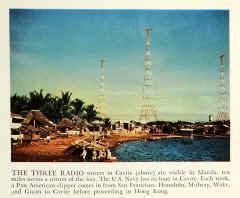
|
NPL San Diego
|
| Space & Naval Warfare Systems Center, San Diego - "The
history of electronic technology began on Pt. Loma a long time before the
establishment of the laboratory here in 1940. On May 12, 1906, a chief
petty officer and two sailors drove a horse-drawn wagon to the downtown
pier and loaded up a Massie 5-kw. transmitter/receiver, the
state-of-the-art in communications. This was the new age of "wireless
radiotelegraphy," which the Navy would eventually shorten simply to
"radio." Many hours later, in the little station house they’d
set up on top of the hill, in a spot now occupied by our technical
library, just off a rutted dirt road that would someday become Catalina
Boulevard and Cabrillo Memorial Drive, the equipment had been installed.
The chief sat down and tapped out a hopeful message to the Mare Island
Naval Radio Station. He was hopeful, because the distance record for Navy
wireless communication at the time was about 125 miles, and Mare Island
was 500 miles away. He was stunned by an immediate reply, and in
celebration commissioned the facility as Navy Radio Station Pt.
Loma." |
NPL San Diego - Pt. Loma - 1924
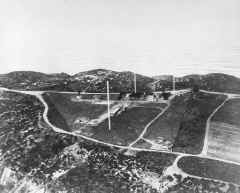
|
NPL San Diego - Pt. Loma - 1924
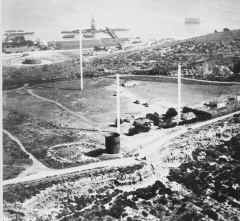
|
NPL San Diego - Pt. Loma - 1934
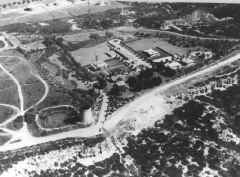
|
NPL San Diego - Pt. Loma - 1942
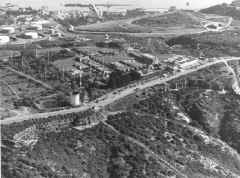
|
Massie Wireless 5kw transmitter
NPL San Diego - Pt. Loma - 1906
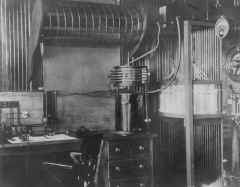
|
North Island 1922
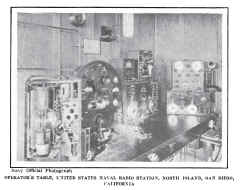
|
NPL - Chollas Heights - 1919
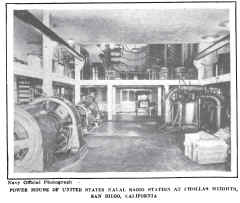
|
NPL - Chollas Heights - 1917
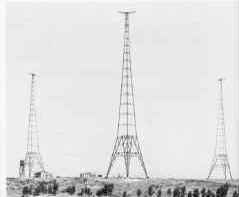
|
NBA Panama Canal Zone - 15th Naval District
- Early
Photos from Sparks Journal - thanks to John Dilks & Society of
Wireless Pioneers
- DN - Darien - 100 KW Federal Arc Transmitter,
three 600' towers 900' apart,
1915-1937
- NBA - Balboa
- NAX - Colon
- NNT - Cape Mala
- NNW - La Palma
- NQB - Toro Point
- NRK - Puerto Obaldia
|
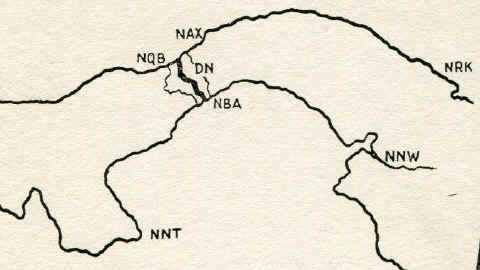
|
Starting instructions for NBA's Federal Arc at Darien:
*Unground main antenna and close switch to arc.
*Start keying machine and close breaker, exciter and keying line switches, adjusting to 100 volts.
*Close control line switch and cut in main relay feeders.
*Close 440-volt motor-generator supply switch and starting controller switch.
*Press start button and hold in until second clapper closes.
*Close generator paralleling switches.
*Close main arc breakers.
*Turn on cooling water and adjust pressure to chamber and anode .
*Adjust kerosene and alcohol needle valves for one drop of mixed liquid per second.
|
*Close d. c. auxiliary switch and start carbon rotating motor.
*Adjust main generators to approximately 600 volts with balanced output current.
*Close number 1 clapper.
*Strike arc.
*Draw flame to 40 amperes.
*Close number 2 clapper.
*Adjust flame to less than 50 amperes.
*Close number 3 clapper.
*Adjust flame to 50 amperes.
*Close number 4 clapper and adjust for maximum output.
*Close 'D' plug on line 100.
*Notify Balboa "GA D4."
|
NBA Darien CZ 1935
US Navy photo (hi-res scan)
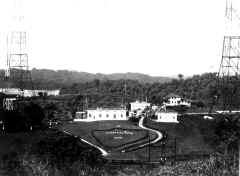
|
NBA Darien, Panama
Decommissioned 12/31/1937
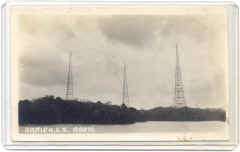
|
NBA Darien (Balboa), Panama
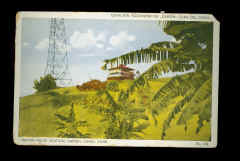
|
NBA Darien 1920
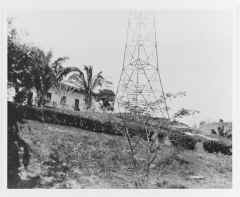
|
NBA Darien
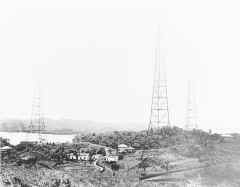
|
NBA Balboa Panama
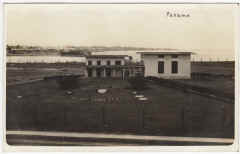
|
NBA Balboa Panama
- later than one to left
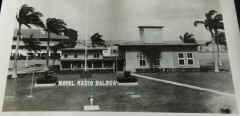
|
NBA Balboa, Panama
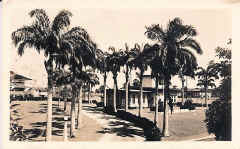
|
NBA Balboa, Panama
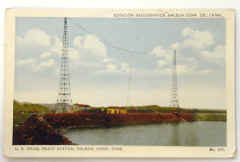
|
Balboa - under construction
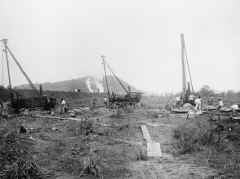
|
Balboa - 1921
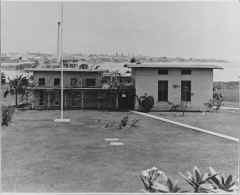
|
NAX Colon, Panama
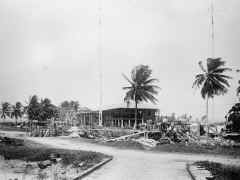
|
NPH - U. S. Naval Radio Station, Russian Island (Vladivostok)
|
|
from
a 1919 report - U. S. Naval Radio Station, Russian Island (Call sign NPH):
Located on Russian Island, Siberia (Vladivostok). Equipped with a 60 kw
arc set, and a 12 kw arc set. At the present time no permanent wave
lengths have been assigned.
Radio Communication: Tests are being made to
establish schedules for this station. At the present time communication
is effective with Peking, Cavite, Guam and with ships within range of
the station. Can communicate with St. Paul and Cordova, Alaska. Signals
are very weak from those stations, but it is expected to establish
effective communications in the near future.
Recommendations have been made to lay a cable from
the station to Vladivostok, a distance of about fifteen miles, for both
telephone and telegraph service. It is expected that this cable will be
laid by winter (1919). The Vladivostok end will be at the headquarters
of the American Expeditionary Forces, with a loop to a U. S. ship in
port. Telephone communications may be had at the Russian Island Red
Cross Hospital, about one mile from the station, which connects to
Vladivostok by cable.
Comment: This station will probably handle commercial
traffic as well as Government traffic. It is of military value in
furnishing communication to and from the American Expeditionary Forces
in Siberia, and for communicating with vessels of the Fleet in Chinese
and Japanese waters.
This station was taken over from the Russian
Government, and was equipped with apparatus furnished by the Navy Yard,
Mare Island, and equipment taken from the Heeia Point Station,
Honolulu and was commissioned about 30 May 1919.
U.S. Naval Radio Station, Heeia Point, Territory
of Hawaii. The original Federal arc transmitter was dismantled and
shipped to Vladivostok 7 December 1918
|
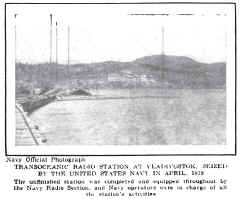
|
The site today
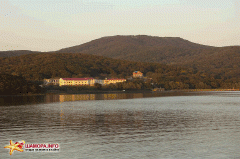
|
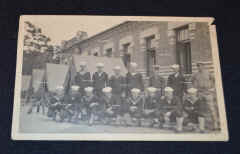
|
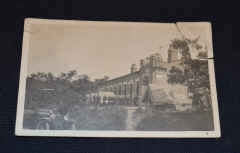
|
Receiving Equipment
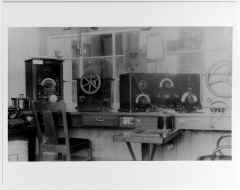
|
Transmitting Equipment
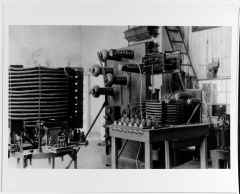
|
Main building, Spring 1919
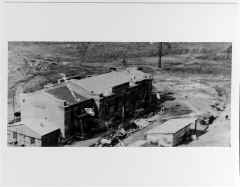
|
Late Winter 1919
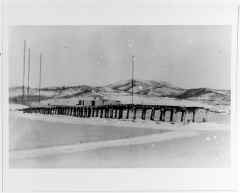
|
Portable tower
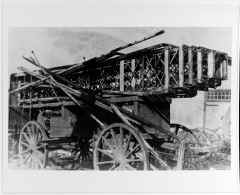
|
300' wooden tower

|
Unloading equipment from USS Saturn
January 1919
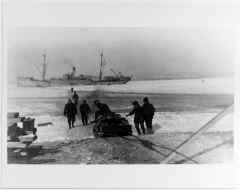
|
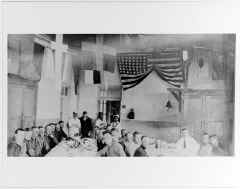
|
NAH New York City - Brooklyn Navy Yard
|
| From 1919 presentation
on the Naval Communication Service - To illustrate how a naval communication district acts, I should like
to take as an example the Third Naval District, which extends from Rhode Island to Barnegat Inlet, and in which there are eight coastal
radio stations which are located as follows: Montauk. L. I.; Fire Island, L. I.; Rockaway Beach, L. I.; Sea Gate, N. Y.; Bush Terminal, N. Y.;
Navy Yard, N. Y.; Mantoloking, N. J., and New London, Conn. There are also five radio compass stations located as follows:
Montauk Point, L. I.; Fire Island. L. I.; Rockaway Beach. L. I.; Sandy Hook, N. J., and
Mantoloking, N. J. These radio and compass stations are all controlled from one Central Control Station, located at No. 44 Whitehall Street,
New York City, at which place are also the offices of the District Communication Superintendent. Direct wires from each of these stations
lead into the Central Control Station, and by means of a plug-board arrangement similar in type to that used by the telephone companies, any
one of these stations may be used as a transmitter by the operator on watch at the control station.
The control station is divided into a number of booths which are magnetically shielded from one another and which contain receiving apparatus
of the most up-to-date type. Each booth is given a wave-length which the operator on watch must guard. There is no transmitting apparatus
at this control station, all transmitting being done by means of distant control through one of the other stations mentioned above. Therefore,
if the operator on watch at 600 meters receives a call and desires to answer, he promptly plugs in on a wire to any station he may decide to
use and transmits via that station. He is listening all the time to what he is sending and should he hear a distress signal, he could instantly stop
and give his attention to the distress call.
A chief electrician (radio) is on duty at this control station as supervisor of traffic. On his desk he has a receiver which enables him to listen
in and keep check on the traffic being handled on the various wave-lengths,
and, from time to time, gives orders to the various operators and stations
so as to avoid interference. Such a system of supervision was found necessary in order to overcome some of the
difficulties brought about by the large increase in radio traffic about the port of New York. The
excellent manner in which this system functions locally about the port of New York is another illustration of the necessity of radio supervision
by one central controlling agency.
All the stations in the Third Naval District, however, are not at all times controlled from the Central Control Station. If
traffic warrants it, some outlying station, such as Montauk or Fire Island, is given orders
by the supervising electrician to handle traffic independently. At such times, the outlying stations are practically acting as agents for the control
station.
The radio compass stations are controlled in a manner similar to the radio transmitting stations in the Third Naval District. Each compass
station in the district is connected with the Compass Control Station at No. 44
Whitehall Street, New York City (which is in the same room with the Radio Control Station) by means of direct wires. The compass stations are not equipped with transmitters, and, therefore. never work
independently of the Control Station, but forward all their bearings to the
supervising operator.
|
| Antenna
in Brooklyn Navy Yard
Antenna
in Brooklyn Navy Yard
|
Fire Island 1916 - Radio Compass Station
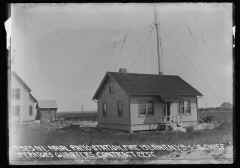
|
Sandy Hook NJ - Radio Compass Station
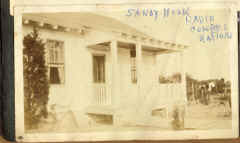
|
NAH 1924
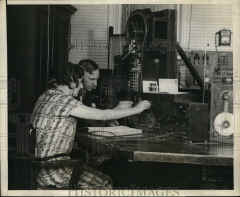
|
NFF Belmar NJ - World War I Operations
|
| Info from Frank W3LPL - The Navy routed Sayville, Tuckerton and New Brunswick and transatlantic cable traffic via Belmar during the war. Transatlantic telegraph cables carried most transatlantic military communications throughout the war. The Navy's biggest fear was that the Germans could cut the transatlantic cables at any time.
Belmar used the NFF call sign when it keyed its primary transmitter at New Brunswick. Belmar also keyed
Sayville and Tuckerton primarily as backups for New Brunswick.
The U.S. Navy took over supervision of Tuckerton and Sayville to protect U.S. neutrality after the start of the war in Europe in 1914. Both continued to be operated by German staff members under Navy supervision until April 7, 1917, when German staff members became prisoners of war. Sayville and Tuckerton were backups to New Brunswick during major station upgrades and planned and unplanned outages. Fire was always a major threat at the high powered radio stations.
When the Navy took over New Brunswick it found a station with obsolete Marconi equipment that had never been used operationally because its partner stations in Wales were taken over by the British government at the onset of World War I in 1914, only brief tests had taken place before the war.
The Navy undertook a crash program to replace obsolete equipment at all three stations. A 50 KW Alexanderson alternator was installed in New Brunswick in 1917 then a 200 KW Alexanderson alternator in 1918. Sayville was upgraded with a 200 KW Federal Arc transmitter.
Info from NRL history - "In October 1917, Dr. A. Hoyt Taylor was directed by the Navy Department to assume responsibility for the establishment and operation of a transatlantic radio communication system with headquarters at Belmar,
NJ. This system comprised facilities taken over by the Navy from commercial interests, principally the Marconi Wireless Company, under powers incident to war. The facilities included transmitting stations located at New Brunswick,
NJ (call letters WII, later NFF, 200 kW, 22.05 kHz), Tuckerton, NJ (call letters WGG, later NWW, 100kW, 18.85kHz), Sayville, Long Island,
NY (call letters SLI, later NDD, 100 kW), and receiving stations at Belmar,
NJ, Chatham, MA, and Bar Harbor, ME.
This system represented the most comprehensive assembly and centralized control of radio equipment accomplished up to that time.
Through its use the principal functions of radio communication during World War 1, i.e., communication with European stations and broadcasts to ships in the Atlantic, were carried out. All World War I transatlantic radio communications were handled by this system, with Belmar as a relay center for messages to and from Washington via telegraph circuits. Communication was maintained with high-power foreign radio stations at Carnarvon, England (call letters MUU, 300 kW, 21.13 kHz), Lyons, France (call letters YN, 150 kW, 22.2 kHz), Nantes, France (call letters UA, 33.35 kHz), Stavanger, Norway (call letters LCM, 300 kW, 25.00 kHz), and Rome, Italy (call letters IDO, 350 kW, 28.57 kHz).
The German version of the war events, transmitted from the high-power station at Nauen, Germany (call letters POZ, 600 kW, 23.80 kHz) was monitored. The messages leading to the armistice were interchanged directly with the Nauen station."
|
NFF Belmar NJ 1917
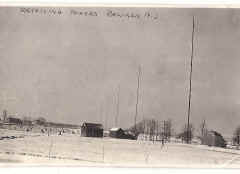
|
NFF Belmar NJ 1917
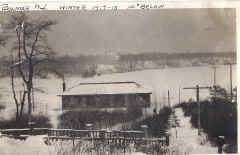
|
NFF Belmar NJ 1917
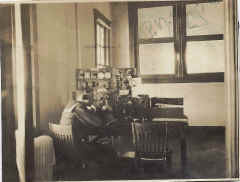
|
NFF Belmar - receiver
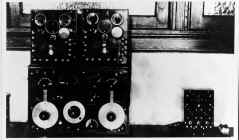
|
NFF Belmar - Wheatstone automatic transmitter
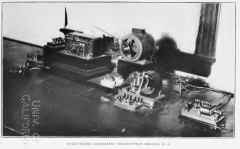
|
From USN
History of Engineering Bureau in WW1 - "The experience of the summer of 1917 was sufficient to
demonstrate that communication with European stations during the summer period was extremely precarious and inefficient, owing to
the summer phenomena of weak signals accompanied by heavy strays (static). The successful development at Great Lakes of the reception
of radio signals on the Rogers submarine and subterranean antenna system induced the Bureau to install this system at Belmar,
N. J., the radio station at this place having been taken over in April from the Marconi company, but not operated.
By the end of October, 1917, Belmar was receiving on submerged wires laid on
the inlet and on a 2,000-foot long land wire buried 2 feet deep. Belmar then became the control center for trans-Atlantic work."
|
NFF- New Brunswick
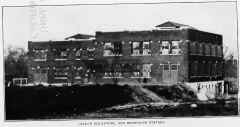
|
NFF- New Brunswick - installation of 200kw
Alexanderson alternator
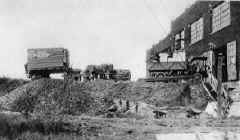
|
NFF- New Brunswick - 200kw Alexanderson
alternator
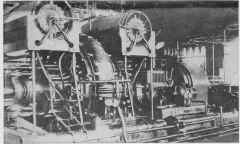
|
NFF- New Brunswick - 200kw Alexanderson
alternator
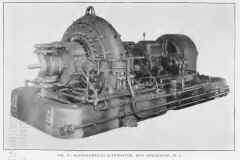
|
Chatham MA (NQW)
Receiving site WCC taken over by US Navy during WW1 and again during WW2.
Active from October 1942 to June 1945 as "station C”, callsign NQW,
|
|
Info at NARA in Record Group 38, Crane Material, Inactive Stations,
see here
Box 24 – Box 29, Box 129 – Box 130 and Box 138
|
LY - Lafayette Transmitter Site - Bordeaux
(Croix d'Hins), France
|
1 MW (500KW HF) Poulsen arc
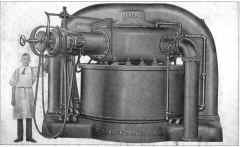
from Ellery W. Stone (1919) "Elements of Radiotelegraphy"
|
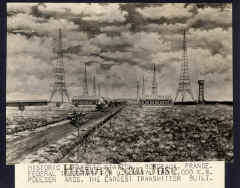
|
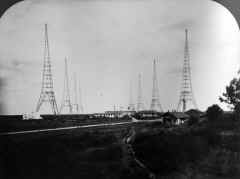
|
Transmitter building
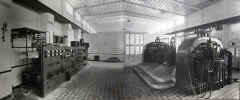
|
Two 1000kw arc transmitters
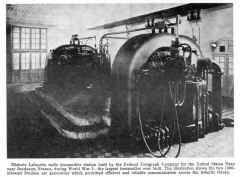
|
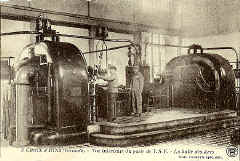
|
| Construction photos 1918
|
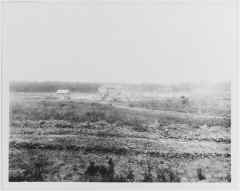
|
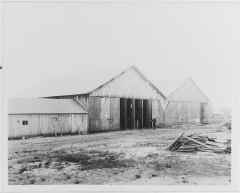
|
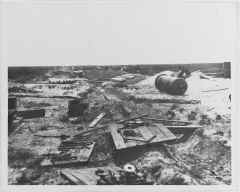
|
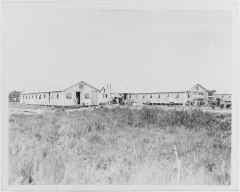
|
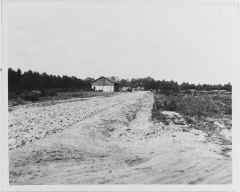
|
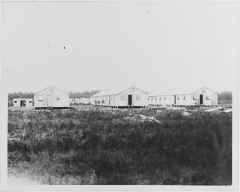
|
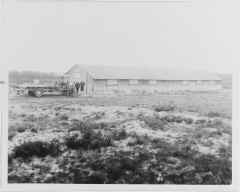
|
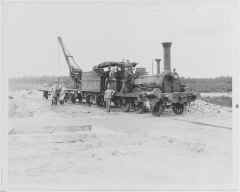
|
US Naval Radio Station, Tutuila, American Samoa (NPU)
(From 14th Naval District reports 1917-19)
Located on the island of Tutuila, American Samoa. Equipped with a 5 kw composite
spark set adjusted to the following wave lengths: 600, 756 (working) and 952 (calling)
meters. Also with a 30 kw arc set adjusted to the following wave lengths: 4000 (calling)
3000, 5000, 6000 and 8500 (working) meters.
Radio Communications: Arc set: Is effective with Pearl Harbor, Heeia Point,
Guam (new arc set), Papeete and probably effective with San Diego and Darien, Canal Zone
and with ships equipped with arc apparatus, depending an their range. It is probable
this set will work with arc stations in New Zealand and Australia. Spark set: Now
effective with Wahiawa (night only), Suva (night only), and Apia, British Samoa. Also
communicates with ships equipped with spark sets, dependent on their range.
Comment: This station handles commercial traffic. It is of military value in
furnishing the only outside communication of the Naval Station and for communicating
with ships of the Fleet in the Pacific. The present spark set is old and in great part
makeshift. There is a semi-high-powered radio station in Apia that works regularly with
Suva and Awanui, New Zealand,, The Apia station contains two 500 cycle quenched spark
sets, one 50 kw and one 10 kw. The apparatus is Telefunken and is practically the same
as that in use in the U. S. Navy. The antennas are of the umbrella type
and are supported by one guyed steelel mast 400 feet high. Apia
communication is now successful with Wahiawa.
There is a 1/2 kw field set in the Manua group, American Samoa, used to
communicate between Ofu and Tau and with Tutuila. This set is for administrative purposes only
and is not open to commercial business. It is operated by hand.
|
|
The 30 kw arc transmitter at Tutuila, Samoa (NPU) was in the same building with
their receivers so they were not able to operate in duplex. Wailupe would transmit
blind, on schedule, then wait for NPU to come on the air with their arc, receipt for
traffic, and then transmit their messages. NPU would then shut down and listen for the
receipt from Wailupe.
|
Photos from Alfred Page Hawes who was stationed
there from May 1921 until January 1923.
- thanks to his son Jim Hawes
|
NPU Antenna Mast
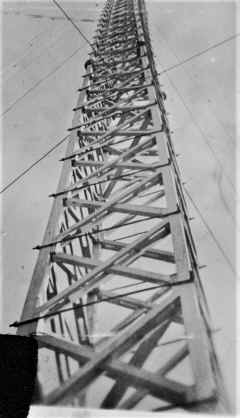
|
Tutuila 1921. Radio Station is in front of the
rear tower. (before the large Marconi tower was built)
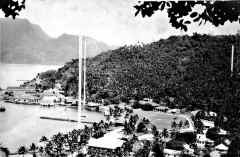
|
US Naval Radio Station Tutuila 1921
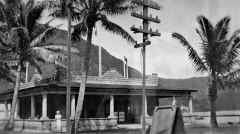 |
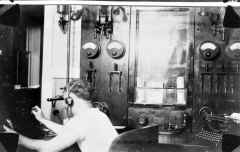 |
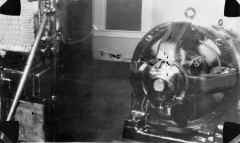
|
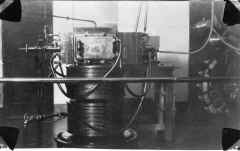 |
== |
| NPU2 Ofu, Samoa - Low Power Station -
Jim believes these may be the earliest days of Ofu before permanent
installation was complete. Year unknown. |
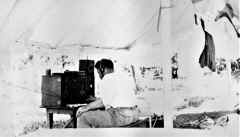 |
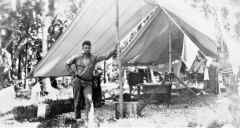 |
== |
== |
| NPU2 Ofu, Samoa after construction |
Ofu
Radio Station and Sick Bay 1922
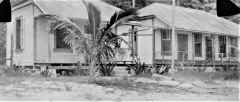 |
Receiver Set NPU2 1921
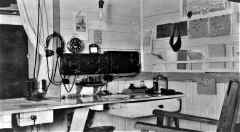 |
Receiver Set NPU2 1922
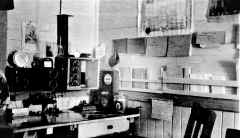 |
Transmitter Panel
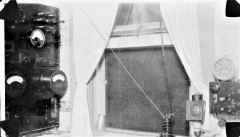 |
Transmitter Panel
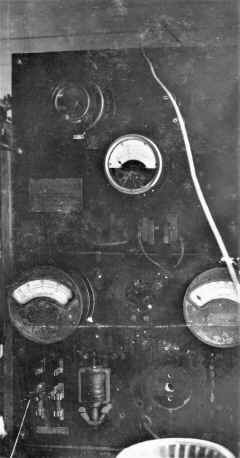 |
== |
== |
== |
| Later Photos showing steel tower |
NPU Tutuila, Pago Pago, Samoa
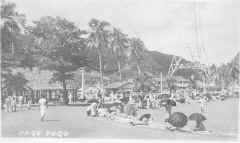
|
NPU Tutuila, Pago Pago, Samoa 1937
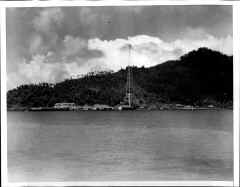
|
1948
color photo |
== |
|
NDD Sayville, L.I. NY 1918
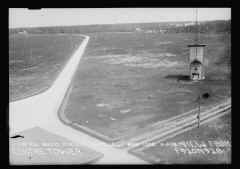
|
NDD Sayville antenna
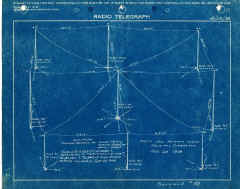
|
1918 Sayville - resistance room
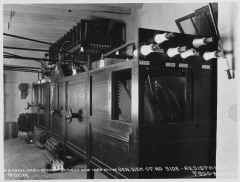
|
Joe Hallock - see
tower renovation story about halfway down page
Tuckerton antenna tower
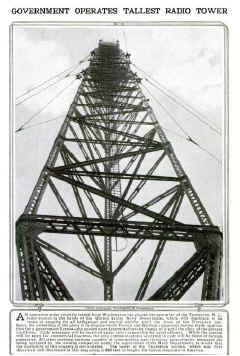
|
| Long Island
Wireless History Site
NDD Sayville, L.I. NY 1918
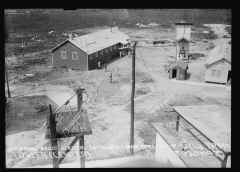
|
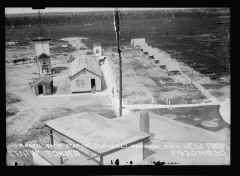
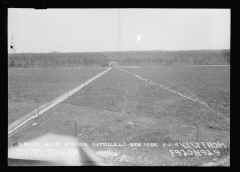
|
1918 Sayville - frequency-changer ?.
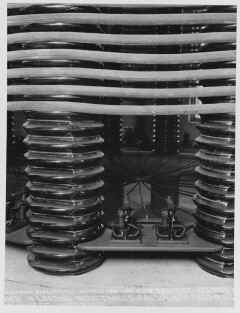
|
NAQ Jupiter Inlet Florida
Lots more photos
here
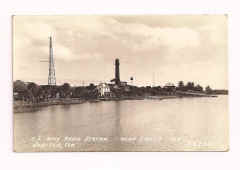
|
NBB St. Thomas Virgin Islands
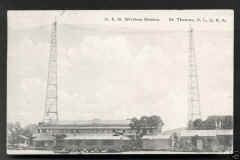
|
NBB St. Thomas Virgin Islands

|
NBB St. Thomas Virgin Islands
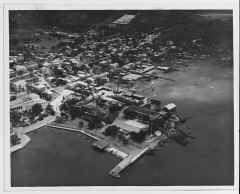
|
| Early
Alaskan Naval Radio Stations - Naval History & Heritage Command - Photo
Collection
|
NPS Kodiak, AK, under construction
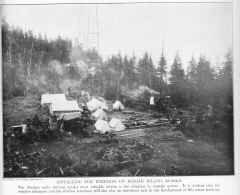
|
NPR Dutch Harbor AK
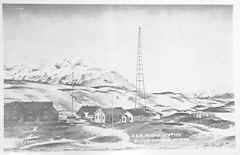
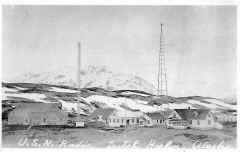
|
NPQ St. Paul, Pribiloff Islands AK
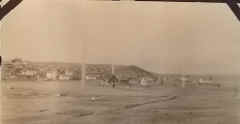
|
NPQ or NPY - Pribilof Islands AK
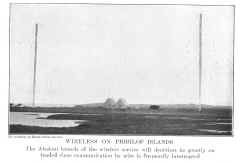
|
NAW Guantanamo
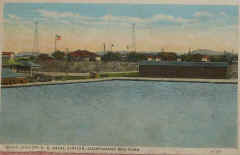
|
NAW Guantanamo
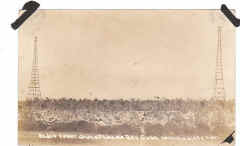
|
NAW Guantanamo
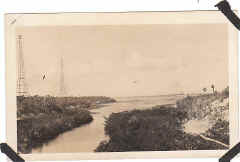
|
NAW Guantanamo
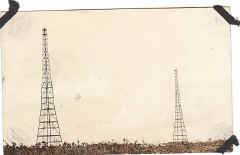
|
Keyport WA, 1929
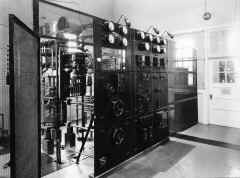
|
NVH Ketchikan Alaska
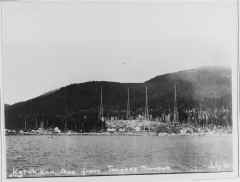
|
NPD Tatoosh Island WA - 1909

|
NAE -Navy Wireless & Marine Signal Station
- Highland, North Truro, Cape Cod, MA
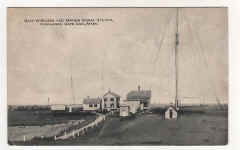
|
NSD - Cape May 1918
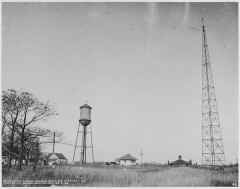
|
Montauk Long Island NY 1919
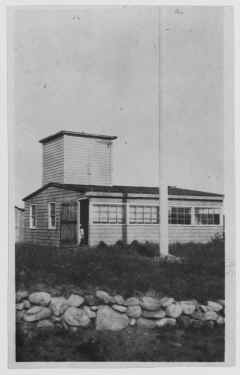
|
Buffalo - 1920
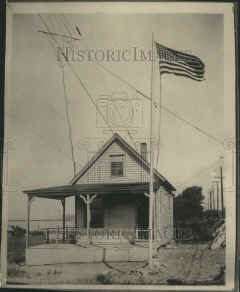
|
Heeia HI - Heeia Radio #6 - South 440-Foot Tower
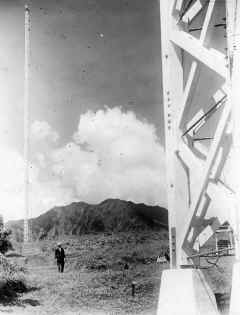
|
NAJ Great Lakes 1917
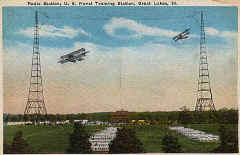
|
NAJ Great Lakes
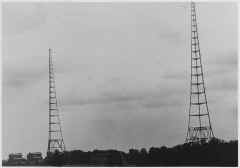
|
NAJ Great Lakes 1930
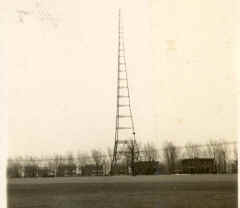
|
Photos
of NAJ equipment
Photo
of NAJ tower
|
NAJ Great Lakes - from "The Great Lakes
Recruit" June 1917
As one is coming in on train or car to the Great Lakes Naval Training Station, long before the numerous and shapely red brick and sandstone buildings of that great camp become visible, he sees looming up in the distance two tall and slender spires of steel. These are the four-hundred foot towers of NAJ, the giant control station of the midcontinental area. This station, erected in 1915, is the naval control station of all of the Great Lakes district, and is the relay station for all naval radio communications requiring to be so handled from the east to the west coasts or vice versa. Owing to the present high efficiency of the naval radio service such relaying is seldom necessary, but NAJ is always ready when unusual atmospheric conditions necessitate its assistance.
For the latter purpose the station is equipped with a powerful transmitter. It is able to work either coast and the Darien station in the Panama canal zone with ease.
For local work and for sending storm warnings, weather and hydrographic reports, and similar service to the ships and stations of the Great Lakes there is a spark transmitter. This is the NAJ familiar to all of the operators of the Great Lakes and vicinity, the commanding note which silences all other radio traffic on the Great Lakes while it sings out the time, weather, or other matter of interest to all stations. Some of the many wave-lengths to which the spark transmitter may be set by the simple turning of a large multi-point switch fall on the "little" aerial:—"little" only in comparison with the dimensions of the big aerial.
There are constantly two operators on watch at the receivers in the sound-proof receiving room. One listens for calls from the high-power arc sending stations, and the other keeps tab of all that is going on among the spark transmission stations.
To man these watches, to keep up the station, and to guard it as is necessary in war time requires quite a numerous personnel, and, consequently, the radio station is now surrounded by a small colony of tents for the men attached to the station. These are in addition to the adequate indoor quarters for the peace footing personnel of the station.
This, the station which carried off the highest average in the recent estimate of the comparative efficiency of all naval radio land stations, was put in commission by radio electricians, D. J. Burk, G. F. Reiling. W. J. Leidy and A. J. Wollweber, directed by Chief Electrician Scanlon who is at present on duty at Arlington, Va., where is located the Navy's master control station.
|
NAT New Orleans, 1922 - Two 300' towers built
in 1915
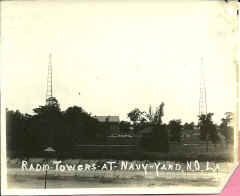
|
The New Orleans towers were
dismantled in 1958
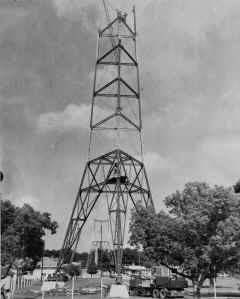
|
NBM Amagansett, LI, NY
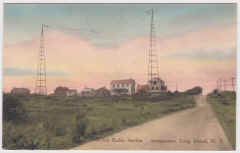
|
Early Transmitter - unknown location
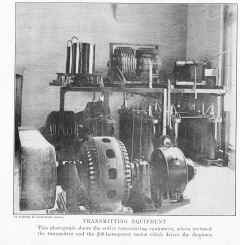
|
Early Towers/Station - unknown location
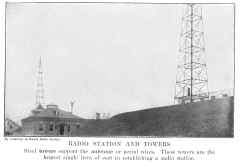
|
NPE - North Head, WA
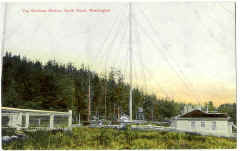
Another NPE photo
|
NPE - North Head, WA - 1907
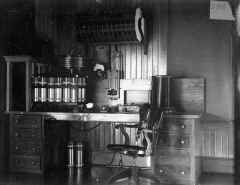
|
NAI - Philadelphia Naval Yard - 1918
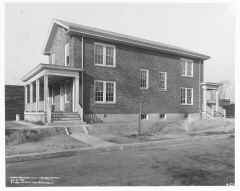
|
NAI - Philadelphia Naval Yard - 1918
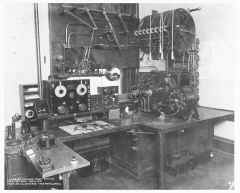
|
NAI - Philadelphia Naval Yard - 1918
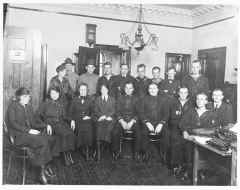
|
Another NAI
photo - 1924
|
|
|
